Related Research Articles

Yue is a branch of the Sinitic languages primarily spoken in Southern China, particularly in the provinces of Guangdong and Guangxi.

Min is a broad group of Sinitic languages with about 70 million native speakers. These languages are spoken in Fujian province as well as by the descendants of Min-speaking colonists on the Leizhou Peninsula and Hainan and by the assimilated natives of Chaoshan, parts of Zhongshan, three counties in southern Wenzhou, the Zhoushan archipelago, Taiwan and scattered in pockets or sporadically across Hong Kong, Macau, and several countries in Southeast Asia, particularly Singapore, Malaysia, the Philippines, Indonesia, Thailand, Myanmar, Cambodia, Vietnam, Brunei. The name is derived from the Min River in Fujian, which is also the abbreviated name of Fujian Province. Min varieties are not mutually intelligible with one another nor with any other variety of Chinese.

There are hundreds of local Chinese language varieties forming a branch of the Sino-Tibetan language family, many of which are not mutually intelligible. Variation is particularly strong in the more mountainous southeast part of mainland China. The varieties are typically classified into several groups: Mandarin, Wu, Min, Xiang, Gan, Jin, Hakka and Yue, though some varieties remain unclassified. These groups are neither clades nor individual languages defined by mutual intelligibility, but reflect common phonological developments from Middle Chinese.
Taishanese, alternatively romanized in Cantonese as Toishanese or Toisanese, in local dialect as Hoisanese or Hoisan-wa, is a Yue Chinese dialect native to Taishan, Guangdong. Although related, Taishanese has little mutual intelligibility with Cantonese. Taishanese is also spoken throughout Sze Yup, located on the western fringe of the Pearl River Delta in Guangdong China. In the late 19th century and early 20th century, most of the Chinese emigration to North America originated from Sze Yup. Thus, up to the mid-20th century, Taishanese was the dominant variety of the Chinese language spoken in Chinatowns in Canada and the United States. It was formerly the lingua franca of the overseas Chinese residing in the United States.

Wu is a major group of Sinitic languages spoken primarily in Shanghai, Zhejiang Province, and the part of Jiangsu Province south of the Yangtze River, which makes up the cultural region of Wu. Speakers of various Wu languages sometimes labelled their mother tongue as Shanghainese when introduced to foreigners. The Suzhou dialect was the prestige dialect of Wu as of the 19th century, but had been replaced in status by Shanghainese by the turn of the 20th century. The languages of Northern Wu are mutually intelligible with each other, while those of Southern Wu are not.
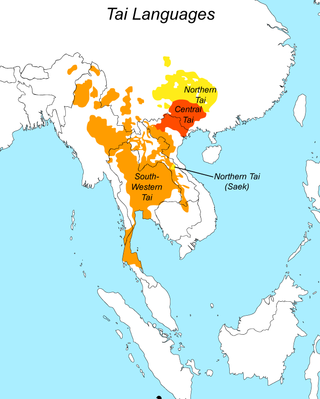
The Tai, Zhuang–Tai, or Daic languages are a branch of the Kra–Dai language family. The Tai languages include the most widely spoken of the Tai–Kadai languages, including Standard Thai or Siamese, the national language of Thailand; Lao or Laotian, the national language of Laos; Myanmar's Shan language; and Zhuang, a major language in the Southwestern China's Guangxi Zhuang Autonomous Region, spoken by the Zhuang people (壯), the largest minority ethnic group in China, with a population of 15.55 million, living mainly in Guangxi, the rest scattered across Yunnan, Guangdong, Guizhou and Hunan provinces.

Cantonese is a language within the Chinese (Sinitic) branch of the Sino-Tibetan languages originating from the city of Guangzhou and its surrounding Pearl River Delta. It is the traditional prestige variety of the Yue Chinese group, which has over 82.4 million native speakers. While the term Cantonese specifically refers to the prestige variety, it is often used to refer to the entire Yue subgroup of Chinese, including related but partially mutually intelligible varieties like Taishanese.
Teochew or Chaozhou is a dialect of Chaoshan Min, a Southern Min language, that is spoken by the Teochew people in the Chaoshan region of eastern Guangdong and by their diaspora around the world. It is sometimes referred to as Chiuchow, its Cantonese rendering, due to English romanization by colonial officials and explorers. It is closely related to some dialects of Hokkien, as it shares some cognates and phonology with Hokkien. The two are mutually unintelligible, but it is possible to understand some words.
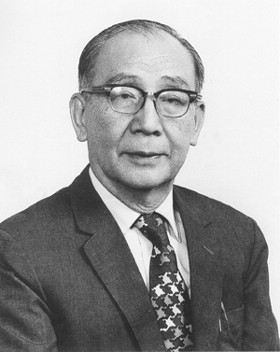
Li Fang-Kuei was a Chinese linguist known for his studies of the varieties of Chinese, his reconstructions of Old Chinese and Proto-Tai, and his documentation of Dene languages in North America.

Pinghua refers to various Sinitic language varieties spoken mainly in parts of Guangxi, with some speakers in Hunan. Pinghua is a trade language in some areas of Guangxi, spoken as a second language by speakers of Zhuang languages. Some speakers are officially classified as Zhuang, and many are genetically distinct from most other Han Chinese. The northern subgroup is centered on Guilin and the southern subgroup around Nanning. The Southern dialect has several notable features such as having four distinct checked tones, and using various loanwords from the Zhuang languages, such as the final particle wei for imperative sentences.
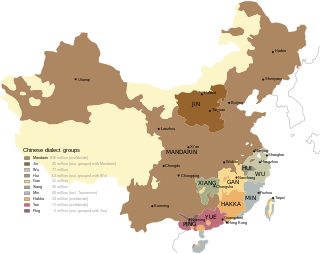
The Sinitic languages, often synonymous with the Chinese languages, are a group of East Asian analytic languages that constitute a major branch of the Sino-Tibetan language family. It is frequently proposed that there is a primary split between the Sinitic languages and the rest of the family. This view is rejected by a number of researchers but has found phylogenetic support among others. The Macro-Bai languages, whose classification is difficult, may be an offshoot of Old Chinese and thus Sinitic; otherwise Sinitic is defined only by the many varieties of Chinese unified by a shared historical background, and usage of the term "Sinitic" may reflect the linguistic view that Chinese constitutes a family of distinct languages, rather than variants of a single language.
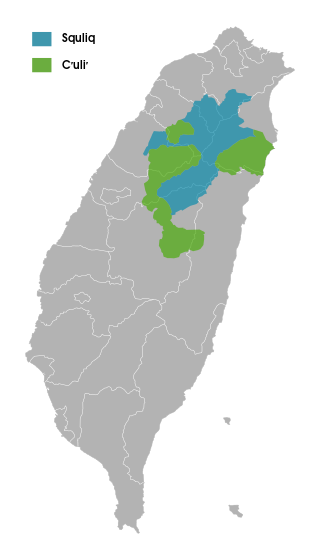
The Atayal language is an Austronesian language spoken by the Atayal people of Taiwan. Squliq and C’uli’ (Ts’ole’) are two major dialects. Mayrinax and Pa’kuali’, two subdialects of C’uli’, are unique among Atayal dialects in having male and female register distinctions in their vocabulary.

The Siyi refers to the four former counties of Xinhui (Sunwui), Taishan (Toisan), Kaiping (Hoiping) and Enping (Yanping) on the west side of the Pearl River Delta in Southern Guangdong Province, China.
The Cantonese Romanisation system known as Barnett–Chao is based on the principles of the Gwoyeu Romatzyh system (GR) developed by Yuen Ren Chao in the 1920s, which he modified in 1947. The B-C system is a modification in 1950 by K M A Barnett from Yuen Ren Chao's romanisation system. It was adopted by the School of Oriental and African Studies, London (SOAS).
Hashimoto Mantarō was a Japanese sinologist and linguist who is best known for advocating research on language geography, linguistic typology, and how different areal features in the varieties of Chinese reflect contact with other language families.
William Hubbard Baxter III is an American linguist specializing in the history of the Chinese language and best known for his work on the reconstruction on Old Chinese.
Chen Li (1810–1882) was a Cantonese scholar of the evidential research school, known for his contributions to historical Chinese phonology.
Jackson T.-S. Sun, also known as Jackson Tianshin Sun, is a Taiwanese linguist working on languages of the Sino-Tibetan and Austroasiatic families. He is best known for his pioneering documentation and historical-comparative work in Tani, Rgyalrongic, and Tibetic languages. Sun is a research fellow at Academia Sinica in Taipei, Taiwan.
Robert Stuart Bauer is the honorary linguistics professor at the University of Hong Kong and formerly professor of Chinese linguistics at the Hong Kong Polytechnic University. He began his study of Cantonese in Taiwan from the United States in 1974 while he was learning Mandarin, then he continued his studies as an exchange student at the Chinese University of Hong Kong in 1970s. Bauer later received his Ph.D. degree in linguistics from the University of California, Berkeley in 1982 and has taught linguistics at universities in Australia, China, Hong Kong, Japan, Taiwan, and Thailand. In 1997, he relocated to Hong Kong permanently, just before the city's handover from British to Chinese sovereignty.
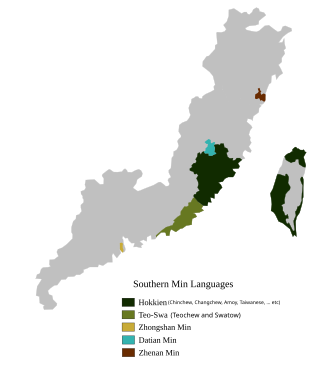
Chaoshan or Teo-Swa is a Southern Min language spoken by the Chaoshan people of the Chaoshan region of eastern Guangdong province, China, and by their diaspora around the world. It is closely related to Hokkien, with which it shares some cognates and phonology, and the two are mutually intelligible.
References
- ↑ Anne Yue-Hashimoto, University of Washington, retrieved 16 March 2024.
- ↑ Ting, Pang-hsin; Cheung, Samuel Hung-nin; Tang, Sze-Wing; Chin, Andy, eds. (2016), New Horizons in the Study of Chinese: Dialectology, Grammar, and Philology – Studies in Honor of Professor Anne Yue, Chinese University of Hong Kong, pp. i–iii, ISBN 978-962-7330-23-3.
- ↑ Chappell, Hilary M., ed. (2001), Sinitic grammar: synchronic and diachronic perspectives, Oxford University Press, p. xvii, ISBN 978-0-19-829977-6.
- ↑ Li Fang-Kuei Society of Chinese Linguistics , retrieved 16 March 2024.